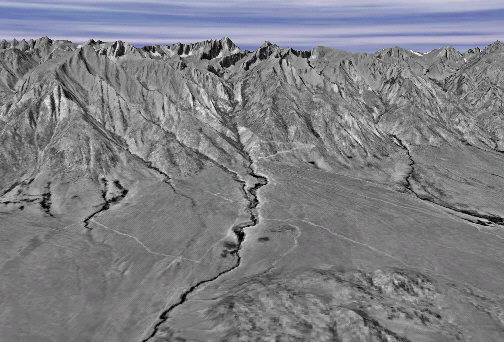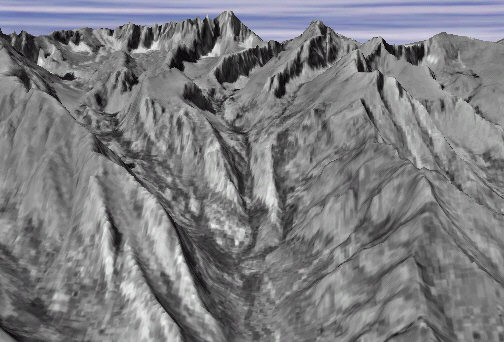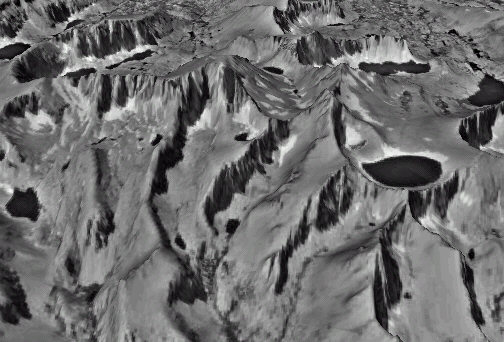
(See related pages)
| Virtual Vista: Mt. Whitney, Sierra Nevada Mountains, California, USA Mountain ranges inspire us with their monumental beauty and ruggedness, creating scenery that stimulates our imaginations and evokes our deepest thoughts. The Sierra Nevada mountains of California are among the most rugged and beautiful in the United States, and were a powerful inspiration to John Muir, who became one of America's greatest naturalists during the 19th Century. Muir's writings of his life in the Sierra Nevada influenced many American naturalists, and were instrumental in making the case that our nation's wild places should be protected as national parks for the enjoyment of future generations.
Among the high peaks of the Sierra Nevada, the highest is Mt. Whitney. At an elevation of 14,494 feet above sea-level, it is the highest mountain in the 48 contiguous United States. In the image below, Mt. Whitney is the highest peak visible just to the left of center (follow the stream valley in the foreground; it leads directly to the peak of Mt. Whitney).
The Sierra Nevada mountains are formed of a series of very large igneous intrusions formed during the Jurassic Period of Earth's history. Later extensional faulting, uplift, and erosion of overlying rocks have exposed the core of the Sierra Nevada mountains along the length of northern California. A normal fault with several kilometers of vertical displacement forms the steep eastern boundary of the Sierra Nevada mountains, and marks the western boundary of the Basin and Range Province.
The high elevations of the Sierra Nevada mountains were extensively glaciated during the Pleistocene ice ages, and provide fine examples of alpine glacial landforms. The towering mountain wall presents a barrier to moisture from the Pacific Ocean, resulting in very arid conditions all along the eastern slope of the Sierras. As such, one can observe many desert landforms (such as alluvial fans, bajadas, sand dunes) are various locations in the valleys east of the Sierra massif. Click on the link below to take an easy "hike" to the summit of Mt. Whitney! Points to Ponder: Having trouble loading or viewing the video clip? You will need the DivX video codec for your media player to watch the video. The DivX codec is available free from www.divx.com. Click on the link or type the URL into your browser to go to the DivX download site. Once at the DivX site, follow the "DOWNLOAD" links until you locate the download "Standard DivX Codec (FREE)" hyperlink. Click on the link and download the small DivX codec file. The codec file may take a few minutes to load. Please be patient. Once the file is downloaded to your local computer, double click on the file to automatically install the Divx codec.You may also discover that the Virtual Vistas work best with the Windows Media Player, available as a free download from www.microsoft.com. Click on the link or type the URL into your browser to go to the Microsoft web site. Once at the web site, type "windows media player" into the Search box, then click on the appropriate link to download the latest version of Windows Media Player. |


